Do I Need Landscape Fabric Under Rocks? Yes, landscape fabric can be beneficial under rocks in certain landscaping applications, but it’s not always necessary. At rockscapes.net, we’ll help you decide when it’s a valuable addition and when it might be overkill, ensuring you make the right choice for your beautiful rock landscape. Let’s explore how using landscape fabrics can prevent gravel sinking, assist with soil reinforcement, and stabilize your base, leading to a longer lifespan for your stunning landscapes and minimizing the amount of time spent on renovation and weed prevention.
Table of Contents
- Understanding Landscape Fabric
- Reasons to Use Landscape Fabric Under Rocks
- Reasons to Avoid Landscape Fabric Under Rocks
- Types of Landscape Fabric
- How to Choose the Right Landscape Fabric
- Proper Installation Techniques
- Alternative Solutions to Landscape Fabric
- Landscape Fabric and Weed Control
- Environmental Considerations
- Cost Analysis: Landscape Fabric vs. Alternatives
- Long-Term Maintenance and Replacement
- Expert Opinions and Research
- DIY vs. Professional Installation
- Rockscapes.net: Your Partner in Landscape Design
- Frequently Asked Questions (FAQs)
1. Understanding Landscape Fabric
What is landscape fabric? Landscape fabric is a permeable material used in landscaping to separate soil from aggregate, suppress weed growth, and stabilize the ground. This material is often made from synthetic materials like polypropylene or polyester and comes in various types, each designed for specific applications.
Landscape fabric acts as a barrier between the soil and the rock layer. It prevents the rocks from sinking into the soil and keeps soil from mixing with the rocks. It also helps in weed control by blocking sunlight from reaching the soil, which inhibits weed growth.
Landscape fabric is commonly used in various landscaping projects, including:
- Gravel Pathways and Driveways: To prevent gravel from mixing with the soil and maintain the integrity of the pathway or driveway.
- Rock Gardens: To suppress weeds and keep the rock mulch separate from the soil.
- Underlayment for Pavers: To provide a stable base and prevent pavers from shifting over time.
- Drainage Systems: To filter soil particles and prevent clogging in French drains and other drainage systems.
2. Reasons to Use Landscape Fabric Under Rocks
Why should I use landscape fabric under rocks? Using landscape fabric under rocks offers several advantages, making it a beneficial addition to many landscaping projects. These advantages include preventing gravel sinking, reinforcing the subgrade, and improving soil moisture.
2.1 Preventing Gravel from Sinking
How does landscape fabric prevent gravel from sinking? Landscape fabric acts as a physical barrier between the gravel and the soil, preventing the gravel from sinking into the soil over time. This is particularly useful in areas with soft or unstable soil.
When rocks are placed directly on the soil, they tend to sink into the ground, especially after rainfall or heavy foot traffic. Landscape fabric distributes the weight of the rocks evenly, preventing them from sinking and maintaining the aesthetic appeal of your landscape. This ensures that the rock layer remains consistent and visually appealing over time.
2.2 Reinforcing the Subgrade
Can landscape fabric reinforce the subgrade? Yes, landscape fabric can reinforce the subgrade, particularly in areas with poor soil quality. It adds stability to the ground and prevents it from shifting or eroding, which is crucial for maintaining the structural integrity of your landscape.
By providing a stable base, landscape fabric can reduce the amount of base gravel needed. For instance, you might be able to use 4 inches of gravel instead of 6 inches, saving both money and effort. This is especially beneficial in areas with less-than-ideal soil conditions, such as clay or sandy soil.
2.3 Stabilizing the Gravel Base
How does landscape fabric stabilize the gravel base? By preventing the mixing of soil and gravel, landscape fabric stabilizes the gravel base, increasing the lifespan of the gravel surface and reducing the need for frequent maintenance.
A stable gravel base is less prone to potholes and erosion. It helps maintain a smooth and even surface, making it easier to walk or drive on. Landscape fabric reduces the frequency of replenishing the gravel surface.
2.4 Moisture Regulation
Does landscape fabric help regulate moisture? Yes, landscape fabric can help regulate soil moisture by preventing excessive evaporation and retaining moisture in the soil. This can be particularly beneficial in dry climates or areas with sandy soil.
By holding in moisture, landscape fabric can reduce the amount of water needed for plants in rocky areas. This is especially useful for plants that thrive in well-drained soil but still require consistent moisture levels.
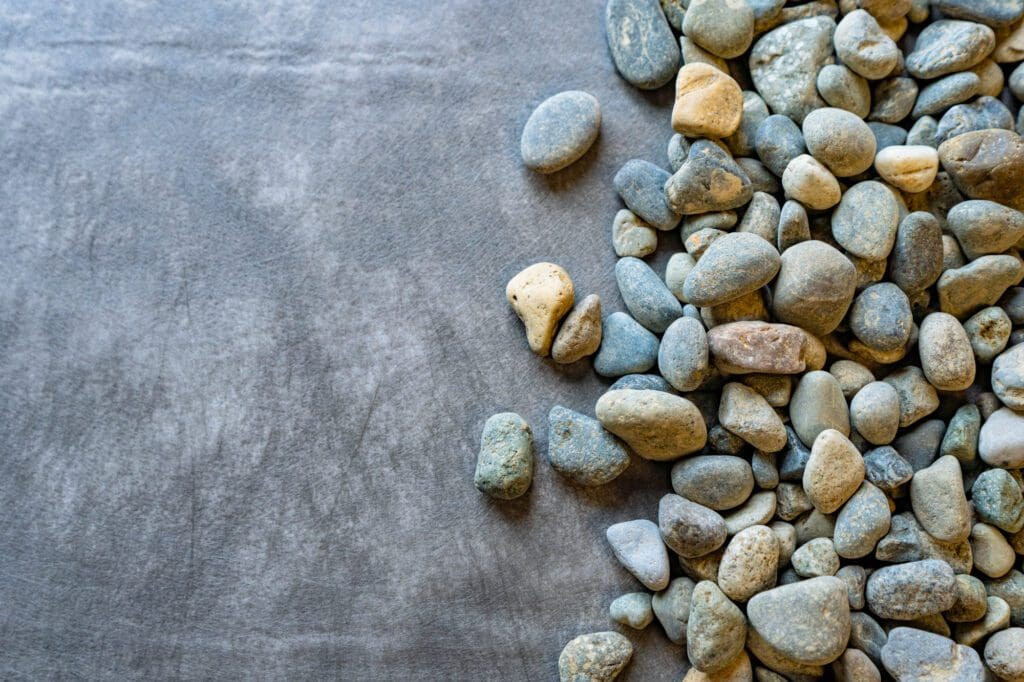 Drain rock is placed on a sheet of nonwoven landscape fabric to create separation from the ground, promoting proper drainage and soil stabilization.
Drain rock is placed on a sheet of nonwoven landscape fabric to create separation from the ground, promoting proper drainage and soil stabilization.
3. Reasons to Avoid Landscape Fabric Under Rocks
Why should I avoid using landscape fabric under rocks? While landscape fabric offers several benefits, there are also reasons why it might not be the best choice for every situation. These include ineffective weed prevention, unnecessary use on good subgrades, its expiration date, and potential harm to soil health.
3.1 Ineffective Weed Prevention
Is landscape fabric effective for long-term weed prevention? Landscape fabric may not be an effective solution for long-term weed prevention, especially in areas where crushed minus gravel is used. While it can prevent weeds from growing deep roots, it won’t stop them from germinating on the surface.
Weeds can still grow in gravel, whether or not landscape fabric is used. Organic matter like leaves and seeds can break down over time and provide a medium for weeds to grow. Weed roots can even get entangled in the fabric, making them more difficult to remove.
The rock fines in crushed rock may act as a medium for aggressive weeds to grow in. Consistent maintenance and removal of organic matter are crucial for preventing weed growth, regardless of whether landscape fabric is used.
3.2 Unnecessary Use on Good Subgrades
When is landscape fabric unnecessary? Landscape fabric may be unnecessary for gravel driveways and pathways if the subgrade is already stable and well-prepared. Proper preparation and installation of a gravel surface may make landscape fabric redundant.
To properly install a gravel driveway, the area should be excavated to the correct depth, the subgrade compacted, the correct gravel type used, and the gravel base and top dressing spread at the correct depths and compacted properly. Proper installation can minimize future maintenance efforts without the need for landscape fabric.
3.3 Limited Lifespan
Does landscape fabric have a limited lifespan? Yes, landscape fabric breaks down over time and needs to be replaced, which can be a nuisance. Even non-biodegradable fabric has an expiration date and will eventually need to be removed along with any materials on top of it.
Consider the estimated lifespan of the fabric and whether the effort of digging it up in the future is worth it. Landscape fabric is great for temporary weed control solutions.
3.4 Potential Harm to Soil Health
Can landscape fabric harm soil health? Yes, some gardeners and landscapers believe that landscape fabric could be detrimental to soil, plant, and human health. Most landscape fabrics are petroleum-based, which can be a concern, especially where produce is grown.
The barrier that landscape fabric offers may lead to unintended consequences. The soil underneath can become dense and compacted. Nutrients from decaying matter like compost or mulch are unable to reach and enrich the underlying soil. Earthworms, which are essential to soil health, are unable to surface.
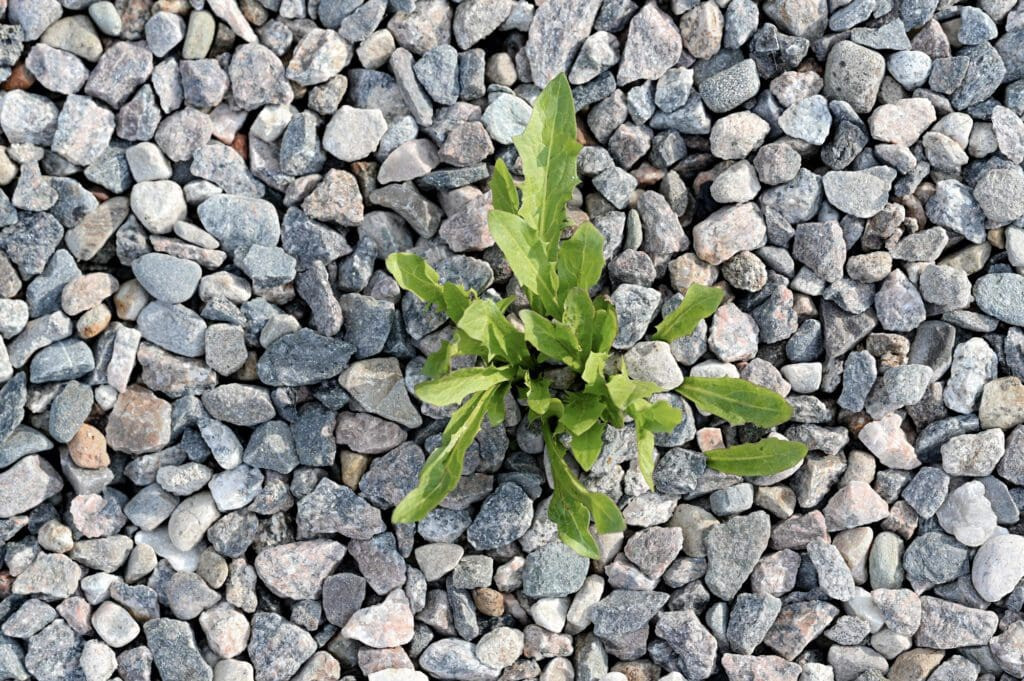 Weeds can still germinate and grow in gravel despite the use of landscape fabric, requiring consistent maintenance and weed removal efforts.
Weeds can still germinate and grow in gravel despite the use of landscape fabric, requiring consistent maintenance and weed removal efforts.
4. Types of Landscape Fabric
What are the different types of landscape fabric? Landscape fabrics come in two basic types: woven and nonwoven. Each type has its own characteristics and is suited for different applications. Some suppliers also classify plastic sheeting and burlap as landscape fabric, but here, we will focus on woven and nonwoven varieties.
4.1 Woven Landscape Fabrics
What are woven landscape fabrics? Woven landscape fabrics typically look like a woven black or white plastic sheet. They are made by weaving together linen, polypropylene, or polyester yarns. Some woven fabrics include green lines to help with planting neat rows of plants.
The tight weave interlocks the fibers, making woven fabric less permeable than non-woven fabric. This means that water cannot pass through as easily. However, some woven landscape fabrics are designed with enhanced permeability.
Generally, the higher the grade of woven landscape fabric, the higher the tensile strength, which means that the fabric can handle heavier loads, better resist tearing, and last longer.
Woven landscape fabrics are often used under gravel driveways and paths to separate gravel from dirt and to provide structural reinforcement. When used in planting, growers will cut or burn holes in the fabric so that water reaches plants but doesn’t penetrate unused soil, which helps with weed suppression and water conservation.
4.2 Nonwoven Landscape Fabrics
What are nonwoven landscape fabrics? Nonwoven fabrics look a little like a thin gray or black felt. They are typically made by bonding together long and short threads of synthetic fibers, like polyester or polypropylene. Sometimes heat is applied to seal the bond of the fibers by melting them.
Nonwoven landscape fabrics are more permeable than woven landscape fabrics, making them a good choice for areas that need drainage, such as around French drains, under permeable pavers, and behind retaining walls.
Nonwoven landscape fabric is generally sold by weight (e.g., 2 oz to 16 oz). Usually, the heavier the fabric weight, the more heavy-duty the application. Filtration fabrics tend to be lighter weight (2 oz to 6 oz) while erosion control fabrics tend to be a heavier weight (8 oz to 16 oz).
4.3 Hybrid Landscape Fabrics
Are there hybrid landscape fabrics? Yes, at least one supplier manufactures a hybrid landscape fabric that has a woven side and a nonwoven side. The manufacturer advertises it as a heavy-duty weed blocker that allows water to pass through while preventing weed growth. Compared to standard woven landscape fabrics sold in hardware stores, it has a slightly higher flow rate, making it slightly more permeable.
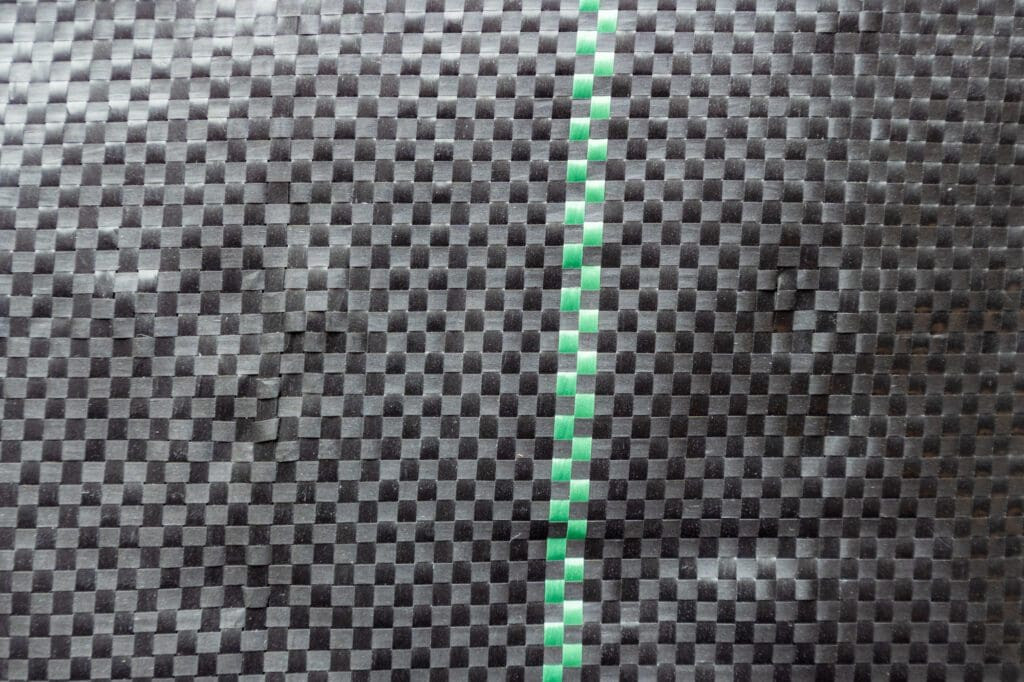 A close-up of woven landscape fabric shows the black threads crisscrossing to create a strong and durable barrier with enhanced tensile strength.
A close-up of woven landscape fabric shows the black threads crisscrossing to create a strong and durable barrier with enhanced tensile strength.
5. How to Choose the Right Landscape Fabric
How do I choose the right landscape fabric for my project? Choosing the right landscape fabric depends on the specific needs of your project. Consider the type of rock you’re using, the purpose of the fabric (weed control, drainage, stabilization), and the environmental conditions.
- For Drainage and Erosion Control: Use a nonwoven fabric for drainage and erosion control (e.g., French drains, rock behind retaining walls, drainage fields, etc.). Water will be able to pass through and drain into the subgrade while keeping sand, soil, and silt from clogging the drain rock.
- For Driveway, Path, and Patio Underlayment: Use a woven stabilization fabric as a driveway, path, and patio underlayment and soil stabilizer. Because woven fabric is less permeable than nonwoven fabric, gravel surfaces must be crowned so that water drains off the edges of the project area.
- For Permeable Gravel Surfaces: Use a nonwoven fabric underneath paths, patios, and playgrounds that use a permeable gravel, clean crushed gravel, pea gravel, or drain rock. The project area must have a stable, well-draining base and subgrade. The purpose of the fabric in this case is to create separation between the rock and subgrade, not to provide structural support.
- For Rock Landscaping: Use either a nonwoven or woven fabric in rock landscaping (dry creek beds, rock used as mulch, etc.). Nonwoven landscape fabric works best where water can drain into the subgrade below the rocks and no structural support is needed. Woven landscape fabric works best where structural support is needed or where the project area is graded so that water can drain away from it.
6. Proper Installation Techniques
Why is correct installation key? To get the benefits advertised, follow the manufacturer’s installation instructions. Improperly installed fabric can lead to tearing and a shorter lifespan, defeating the purpose of using it in the first place.
Installation typically requires removing weeds and leveling the ground; overlapping sections of landscape fabric and pinning fabric in place with landscape staples; cutting holes in the fabric for plants, if applicable; and covering the fabric with gravel, landscape rock, mulch, etc.
Here’s a step-by-step guide to installing landscape fabric properly:
- Prepare the Area:
- Remove all existing weeds, grass, and debris from the area.
- Level the ground to create a smooth surface.
- Compact the soil if necessary to provide a stable base.
- Unroll the Fabric:
- Unroll the landscape fabric over the prepared area.
- Overlap sections of fabric by at least 6-12 inches to prevent weed growth between seams.
- Secure the Fabric:
- Use landscape staples or pins to secure the fabric to the ground.
- Place staples every 12-18 inches along the edges and seams.
- Ensure the fabric is taut and lies flat against the ground.
- Cut Holes for Plants (if applicable):
- If you are planting in the area, cut holes in the fabric for each plant.
- Make the holes large enough to accommodate the plant’s root ball.
- Cover with Rocks:
- Spread the rocks evenly over the landscape fabric.
- Use the appropriate amount of rocks to achieve the desired look and functionality.
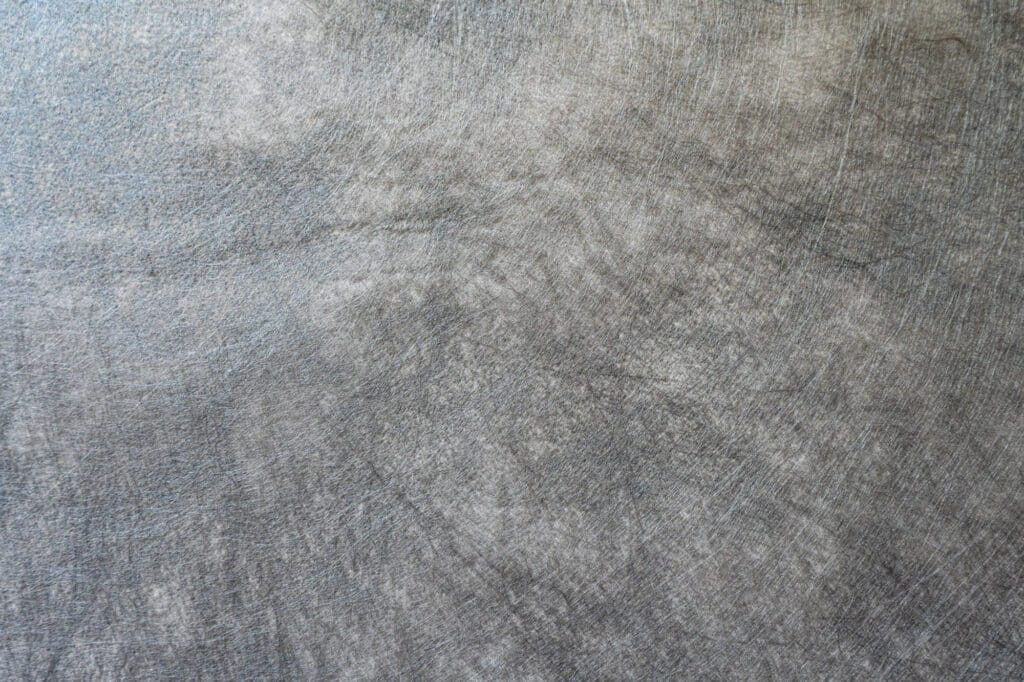 A close-up of gray nonwoven landscape fabric shows the random intersection of fibers, providing permeability for effective drainage in various landscaping applications.
A close-up of gray nonwoven landscape fabric shows the random intersection of fibers, providing permeability for effective drainage in various landscaping applications.
7. Alternative Solutions to Landscape Fabric
What are some alternatives to landscape fabric? If you’re looking for alternatives to landscape fabric, consider using organic mulches, cardboard, or other natural materials. These options can provide weed suppression and soil improvement without the potential drawbacks of synthetic fabrics.
7.1 Organic Mulches
How effective are organic mulches? Organic mulches like wood chips, bark, and compost can suppress weeds, retain moisture, and improve soil health as they decompose. Apply a thick layer of mulch (3-4 inches) to effectively block sunlight and prevent weed germination.
Organic mulches add nutrients to the soil as they break down, improving soil fertility and structure. They also help regulate soil temperature, keeping it cooler in the summer and warmer in the winter.
7.2 Cardboard and Newspaper
Can cardboard and newspaper be used as alternatives? Yes, cardboard and newspaper can be used as effective weed barriers. Lay down a layer of cardboard or several layers of newspaper over the soil, and then cover with mulch or rocks.
Cardboard and newspaper block sunlight and prevent weed growth. They decompose over time, adding organic matter to the soil. Make sure to remove any tape or labels from the cardboard before using it.
7.3 Ground Cover Plants
Are ground cover plants a good alternative? Yes, ground cover plants can provide a natural and attractive alternative to landscape fabric. Choose plants that spread quickly and densely to effectively suppress weeds.
Ground cover plants add biodiversity to your garden and provide habitat for beneficial insects. They also help prevent soil erosion and improve soil health.
8. Landscape Fabric and Weed Control
How effective is landscape fabric for weed control? Landscape fabric can be effective for weed control, but it’s not a foolproof solution. It works best when combined with other weed control methods, such as mulching and hand-pulling weeds.
8.1 Preventing Weed Growth
How does landscape fabric prevent weed growth? Landscape fabric prevents weed growth by blocking sunlight from reaching the soil, which inhibits weed germination and growth. It also acts as a physical barrier, preventing weeds from emerging from the soil.
8.2 Limitations of Landscape Fabric
What are the limitations of landscape fabric for weed control? Landscape fabric has limitations in that it does not prevent weeds from germinating on top of the fabric in accumulated organic matter. Weeds can also grow through small holes or tears in the fabric.
Regular maintenance is necessary to remove any weeds that do manage to grow. Over time, the fabric can become clogged with soil and debris, reducing its effectiveness.
8.3 Best Practices for Weed Control
What are the best practices for weed control with landscape fabric? To maximize the effectiveness of landscape fabric for weed control, follow these best practices:
- Prepare the soil properly: Remove all existing weeds and debris before installing the fabric.
- Overlap seams: Overlap sections of fabric by at least 6-12 inches to prevent weed growth between seams.
- Secure the fabric: Use landscape staples to secure the fabric to the ground and prevent it from shifting.
- Mulch on top: Apply a layer of mulch on top of the fabric to further suppress weed growth and retain moisture.
- Regular maintenance: Regularly inspect the fabric and remove any weeds that do manage to grow.
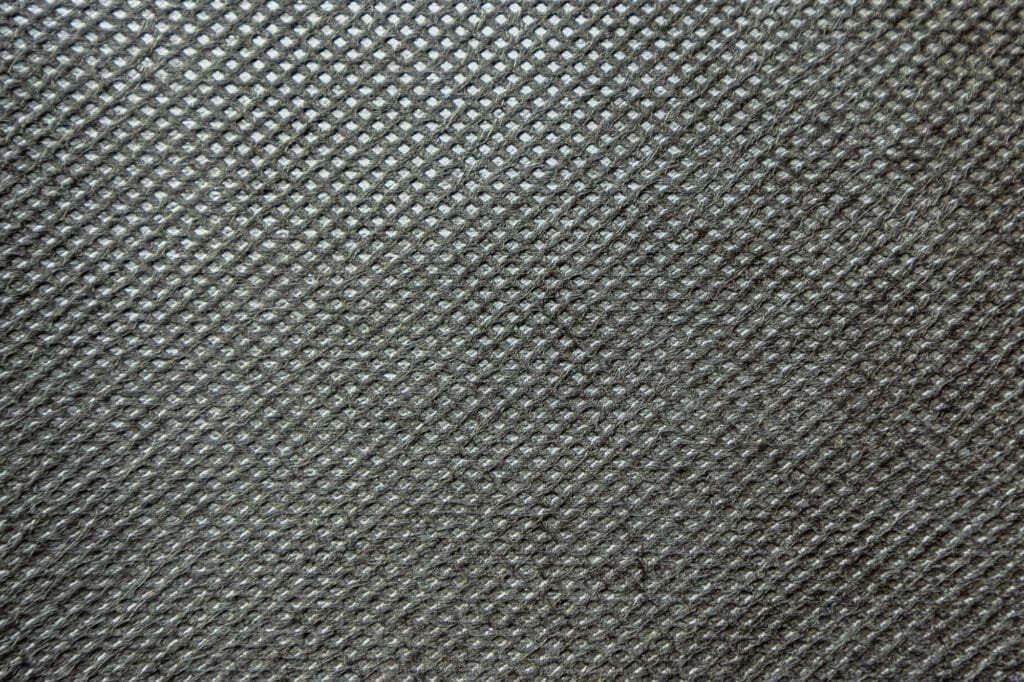 This close-up of point bond fabric reveals a repeating diamond pattern, heat-sealed to maintain permeability and bonding strength for effective weed control and soil stabilization.
This close-up of point bond fabric reveals a repeating diamond pattern, heat-sealed to maintain permeability and bonding strength for effective weed control and soil stabilization.
9. Environmental Considerations
What are the environmental considerations of using landscape fabric? Landscape fabric is typically made from synthetic materials, which can have environmental impacts. Consider the sustainability of your landscaping choices and opt for eco-friendly alternatives when possible.
9.1 Material Composition
What is landscape fabric made of? Most landscape fabrics are made from polypropylene or polyester, which are petroleum-based plastics. These materials are not biodegradable and can persist in the environment for a long time.
9.2 Biodegradable Options
Are there biodegradable landscape fabric options? Yes, some biodegradable landscape fabrics are made from natural fibers like jute or coir. These materials decompose over time, adding organic matter to the soil.
9.3 Recycling and Disposal
Can landscape fabric be recycled? Recycling landscape fabric is difficult, which ends up in landfills. Proper disposal is essential to minimize its environmental impact.
10. Cost Analysis: Landscape Fabric vs. Alternatives
What is the cost of landscape fabric compared to alternatives? Landscape fabric can be a cost-effective solution for weed control and soil stabilization, but it’s important to compare the cost with alternative methods to determine the best option for your budget.
10.1 Material Costs
How much does landscape fabric cost? The cost of landscape fabric varies depending on the type, quality, and quantity. Woven fabrics tend to be more expensive than nonwoven fabrics.
10.2 Installation Costs
Are there installation costs associated with landscape fabric? Installation costs can include the cost of staples, pins, and labor. If you hire a professional landscaper, the installation costs will be higher.
10.3 Long-Term Costs
What are the long-term costs associated with landscape fabric? Long-term costs can include the cost of replacing the fabric every few years, as well as the cost of maintaining the area and removing any weeds that grow.
11. Long-Term Maintenance and Replacement
How do I maintain landscape fabric? Landscape fabric requires regular maintenance to ensure its effectiveness. This includes removing any weeds that grow on top of the fabric, clearing debris, and inspecting the fabric for tears or damage.
11.1 Maintenance Tips
What are some maintenance tips for landscape fabric? Here are some maintenance tips to keep your landscape fabric in good condition:
- Remove Weeds: Regularly remove any weeds that grow on top of the fabric.
- Clear Debris: Clear any debris, such as leaves, twigs, and soil, from the fabric.
- Inspect for Damage: Inspect the fabric for tears or damage and repair them promptly.
- Replenish Mulch: Replenish the mulch layer on top of the fabric as needed.
11.2 Replacement Schedule
When should I replace my landscape fabric? The lifespan of landscape fabric varies depending on the type and quality of the fabric, as well as the environmental conditions. Generally, woven fabrics last longer than nonwoven fabrics.
Replace the fabric when it starts to deteriorate or when it no longer effectively suppresses weeds. This is typically every 5-10 years for woven fabrics and every 2-5 years for nonwoven fabrics.
11.3 Replacement Process
How do I replace landscape fabric? Replacing landscape fabric involves removing the rocks or mulch, removing the old fabric, preparing the soil, laying down the new fabric, and replacing the rocks or mulch.
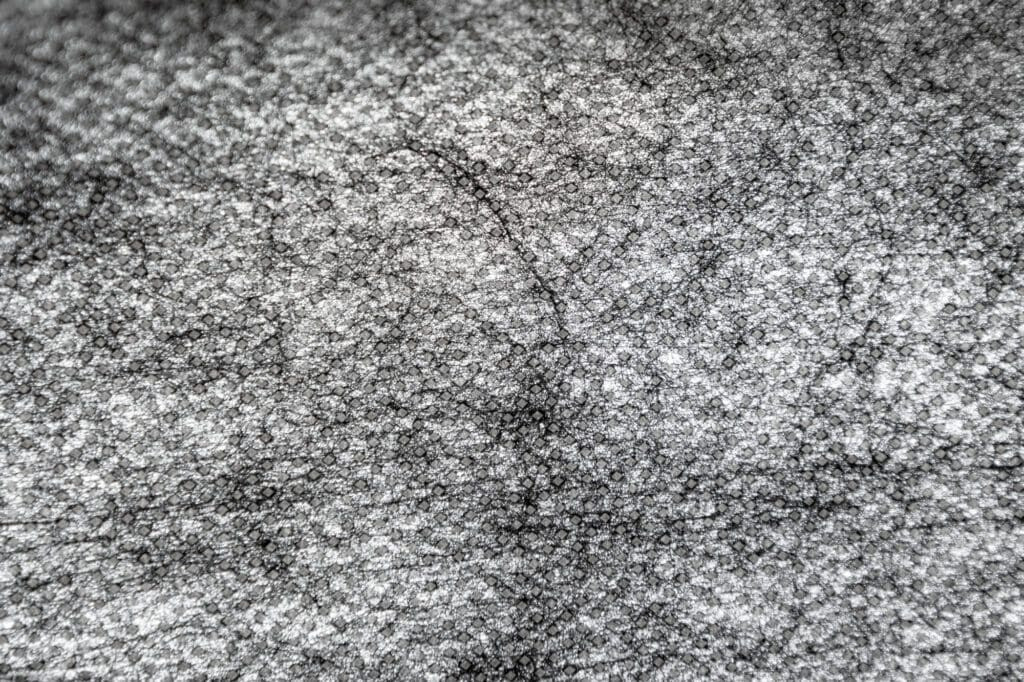 This close-up of point bond fabric, illuminated by a light source, highlights the pattern of sealed dots that enhance its strength and permeability for effective landscape use.
This close-up of point bond fabric, illuminated by a light source, highlights the pattern of sealed dots that enhance its strength and permeability for effective landscape use.
12. Expert Opinions and Research
What do experts say about landscape fabric? There is a lot of debate in the gardening and landscaping realms about whether landscape fabric is worth the hassle and expense. Based on our research, here are some thoughts to consider:
- Arizona State University’s School of Earth and Space Exploration: Their research suggests that the effectiveness of landscape fabric depends heavily on the specific application and the type of fabric used.
- Professional Landscapers: Many landscapers recommend using landscape fabric for specific purposes, such as stabilizing soil and preventing gravel from sinking, but caution against using it as a long-term weed control solution.
- Experienced Gardeners: Some gardeners find landscape fabric to be a valuable tool for weed control, while others believe it can be detrimental to soil health and prefer using organic alternatives.
13. DIY vs. Professional Installation
Should I install landscape fabric myself or hire a professional? Whether you should install landscape fabric yourself or hire a professional depends on your experience, skills, and the scope of the project.
13.1 DIY Installation
What are the benefits of DIY installation? DIY installation can save money on labor costs. It also allows you to have more control over the project and ensure that it is done to your satisfaction.
13.2 Professional Installation
What are the benefits of professional installation? Professional landscapers have the experience and expertise to install landscape fabric properly and efficiently. They can also help you choose the right type of fabric for your project and provide advice on long-term maintenance.
13.3 Factors to Consider
What factors should I consider when deciding whether to DIY or hire a professional? Consider the following factors when deciding whether to DIY or hire a professional:
- Project Scope: If the project is large or complex, it may be best to hire a professional.
- Your Experience: If you have experience with landscaping projects, you may be able to install the fabric yourself.
- Your Budget: DIY installation can save money, but professional installation may be worth the cost if you want to ensure that the job is done right.
- Time Commitment: DIY installation can take a lot of time, so consider whether you have the time to commit to the project.
14. Rockscapes.net: Your Partner in Landscape Design
How can Rockscapes.net help with my landscape design? At rockscapes.net, we offer a wide range of resources to help you design and implement your dream landscape. Whether you’re looking for inspiration, information, or expert advice, we have you covered.
14.1 Design Ideas
What kind of design ideas can I find on Rockscapes.net? Explore our extensive gallery of landscape design ideas featuring rocks, gravel, and other natural materials. Find inspiration for rock gardens, pathways, driveways, and more.
Our design ideas are curated to showcase the beauty and versatility of rocks in landscape design. We offer a variety of styles, from modern and minimalist to rustic and natural.
14.2 Product Information
What product information does Rockscapes.net provide? We provide detailed information about various types of rocks, gravel, and landscape fabrics. Learn about their characteristics, uses, and benefits.
Our product information includes specifications, photos, and customer reviews to help you make informed decisions. We also offer expert advice on choosing the right materials for your project.
14.3 Expert Advice
Does Rockscapes.net offer expert advice? Yes, our team of landscape design experts is available to answer your questions and provide guidance on your project. We can help you choose the right materials, design a layout that meets your needs, and troubleshoot any issues that arise.
14.4 Contact Information
How can I contact Rockscapes.net? You can contact us through our website or visit our location:
- Address: 1151 S Forest Ave, Tempe, AZ 85281, United States
- Phone: +1 (480) 965-9011
- Website: rockscapes.net
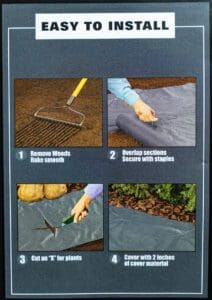 Sample instructions from a package of weed control fabric.
Sample instructions from a package of weed control fabric.
15. Frequently Asked Questions (FAQs)
15.1 What is landscape fabric made of?
Landscape fabric is typically made from polypropylene or polyester, which are synthetic materials. Some biodegradable options are made from natural fibers like jute or coir.
15.2 How long does landscape fabric last?
The lifespan of landscape fabric varies depending on the type and quality of the fabric. Woven fabrics typically last 5-10 years, while nonwoven fabrics last 2-5 years.
15.3 Can I plant through landscape fabric?
Yes, you can plant through landscape fabric by cutting holes in the fabric for each plant. Make sure the holes are large enough to accommodate the plant’s root ball.
15.4 Does landscape fabric prevent all weeds?
Landscape fabric does not prevent all weeds, but it can significantly reduce weed growth by blocking sunlight from reaching the soil. Regular maintenance is necessary to remove any weeds that do manage to grow.
15.5 Is landscape fabric environmentally friendly?
Most landscape fabrics are made from synthetic materials, which can have environmental impacts. Consider using biodegradable options or organic alternatives to minimize your environmental footprint.
15.6 How do I install landscape fabric?
To install landscape fabric, prepare the area by removing weeds and debris, unroll the fabric, overlap seams, secure the fabric with staples, cut holes for plants, and cover with rocks or mulch.
15.7 Can I reuse landscape fabric?
You can reuse landscape fabric if it is still in good condition. Remove any debris, repair any tears, and reinstall the fabric in a new location.
15.8 What are the benefits of using landscape fabric under rocks?
The benefits of using landscape fabric under rocks include preventing gravel from sinking into the soil, stabilizing the ground, suppressing weed growth, and retaining moisture in the soil.
15.9 What are the alternatives to landscape fabric?
Alternatives to landscape fabric include organic mulches, cardboard, newspaper, and ground cover plants.
15.10 How do I choose the right landscape fabric for my project?
Choose the right landscape fabric based on the type of rock you’re using, the purpose of the fabric (weed control, drainage, stabilization), and the environmental conditions.
Ready to transform your landscape with the timeless beauty of rocks? Visit rockscapes.net today to explore our stunning design ideas, discover a wide range of high-quality rocks and materials, and get expert advice from our experienced team. Let us help you create a landscape that not only enhances your property’s value but also brings joy and tranquility to your everyday life. Contact us now and let’s bring your vision to life!